- Author,
a Pahadi tells about why and how Shivaratri is celebrated in Mandi, also known
as Chhoti Kashi, together with some lovely pictures of festival.
Devi’s and Devta’s, God and Goddess are part of the very religious, cultural, social, economic and ecological fabric of Himachal Pradesh, which have rightly earned Himachal it’s popular epithet of Dev Bhoomi (Land
of Gods). One really needs to visit and witness the pristine, picturesque,
serene, and tranquil Dev Boomi to know why.
Faith
is the cornerstone of preservation of any culture and heritage, and it figures
very prominently in Himachal and Himachalis. The way Himachal takes care of its traditions
and customs is reflective in the way it celebrates them, closest to the
original avatar. The amount of faith a pahadi exhibits in their Devi Devta is
unparalleled. Actually this faith emanates from the power and strength of the
Devi/ Devta itself. There are examples galore.
One such e.g. is Mandi’s International Shivratri Festival. In 2022 the festival is from March 2 to 8.
The
14th day, Chaturdashi of waning moon-Krishan Paksha of every Hindu calendar
month, is dedicated to Lord Shiva. Shivrati of Phalgun month is considered very
auspicious and celebrated as Mahashivratri.
Mahashivratri
is celebrated with much fervour and devotion across India, but The
International Mandi Shivratri Festival is a unique amalgamation of culture and
devotion, which makes it a centre of attention and attraction internationally.
It is a spiritual experience combined with a whopping doze of entertainment in the
form of dance, music, Police & Home Guard band processions, competitions,
and other cultural programmes.
As
locals put it, this occasion presents a great opportunity to get Darshan,
blessings of all of Deities at one place. This feeling resonates equally with
all devotees who flock to Mandi during Mahashivratri.
Such
festivities are good for the economy too. It is a time when people loosen their
purse strings and spend, which boosts consumption expenditure i.e. short post
Covid.
Mandi
is the bastion of Himachali/ Pahadi culture, located in the heart of Himachal.
It is home to appr 100 temples, is referred as Chhoti Kashi and is considered Shiv
Nagri (town of Lord Shiva) by locals. Its famous temples include Bhoot Nath
Mandir, Ekadashi Rudra Mandir and Tarna Mata Mandir.
In
Himachal, almost every locality or village has its own deity. The invitations,
called Nimantran, are sent out to
these deities, to become part of grand celebration of Mahashivratri.
During
seven days of the festival period, Mandi receives more than 200 beautifully
adorned Devis and Devatas from all over Himachal. Deities
have different hierarchies and status. Protocols are strictly followed.
![]()
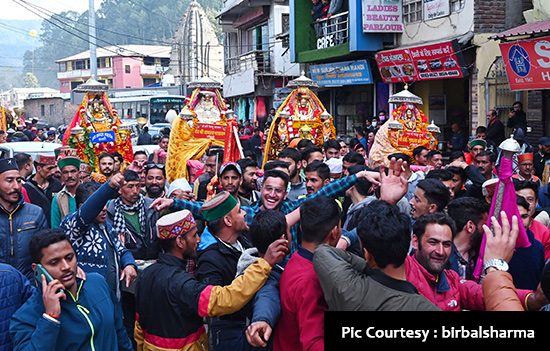 Devis and Devtas arriving in Mandi.
Devis and Devtas arriving in Mandi. These
Devi and Devtas arrive on their beautifully decorated colourful Rath called Palaki (Palanquin), which
are carried by Kardars (attendants of
the deity). Raths are made of gold, silver and other precious metals. Post arrival,
Devi/ Devtas stay at their designated places, called Sthan in local language, as per the tradition and protocol. Only
certain Rajsi Devi Devta go to Raj
Mahal, where they are greeted by Royal family.
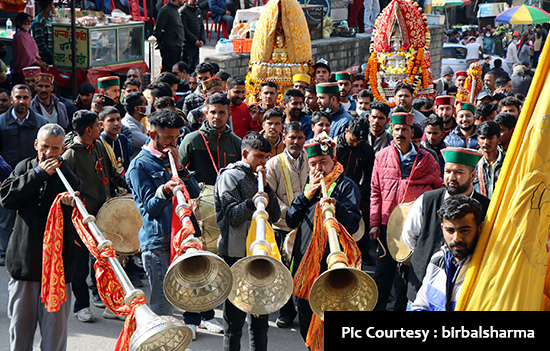 Local Devi Devtas arriving in their Raths. The trumpet is called Thankru.
Local Devi Devtas arriving in their Raths. The trumpet is called Thankru.The most widely believed story on the origin of the festival is that in 1788, around Mahashivratri time the King of Mandi, Aishwaria Sen, was released from imprisonment of Sansar Chand, King of Kangra. All regional people along with their Devi Devtas reached Mandi to pay their respect and homage to King Aishwaria Sen. This tradition is being followed since. They update their king on yearly events.
The
entire celebration is centred around Madhav Rai ji, the principal deity of
Mandi who is an incarnation of Lord Vishnu. All deities who attend the festival
must pay their obeisance to Madhav Rai ji first.
Shobha
Yatra or Procession of deities is called Jaleb in local pahadi language. Jalebs
are made thrice during the festival period of seven days.
 Jaleb (procession) of deities.
Jaleb (procession) of deities. Before
beginning of Jaleb, Madhav Rai ji and other Devi Devatas visit Bhoot Nath
temple to pay homage to Lord Shiva and he is given an invitation for
Mahashivratri. Bhootnath temple, situated in the heart of Mandi is dedicated to
Lord Shiva. It was built by Raja Ajber Sen in 1527 AD.
Mahashivratri festivities begin only after Bada Dev Kamrunag reaches Mandi and as per protocol visits Madhav Rao ji mandir first, takes his blessings and is worshipped in Raj Mahal Behra or Portico, after that he leaves for Tarna Mata. Dev Kamrunag stays in Tarna Mata Mandir during his entire visit of 7 days. He doesn’t participate in any Jaleb.
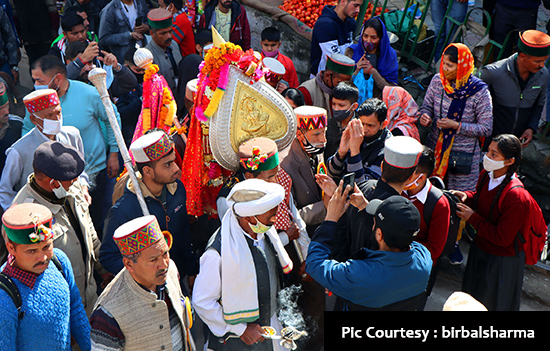 Rath of Dev Kamrunag.
Rath of Dev Kamrunag. For
me connect with Kamrunag Devta is very personal, as he is my Ishta Devta. He is
a prominent Devta and Ishta of many natives of the region, including my
hometown Karsog. Karsog is a beautiful valley in district Mandi, which finds
mention in the Mahabharata. Kamrunag is Ratna
Yaksha (God of rains). He was revered and worshipped by the Pandavas and is
also called Bada Dev.
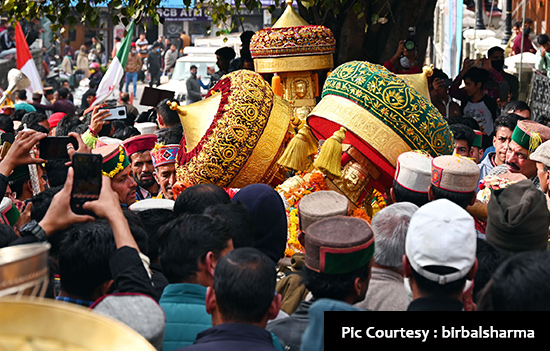 Milap of Devtas
Milap of DevtasThe confluence of deities, and their Milan/ Milap, the way they greet each other while swaying to drumbeats of Dhol & Nagada, tunes of Thankru (big trumpet), Ransingha/ Narsingha (S shape trumpet),
Karnaal, and Shehnai, is a sight in itself. They possess the power to take you
to a different dimension.
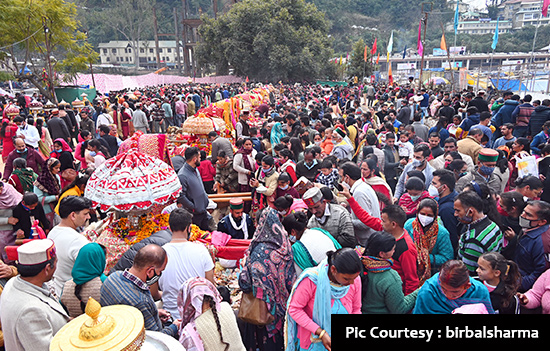 Devi Devta's Rath among huge crowd of devotees in Paddal ground.
Devi Devta's Rath among huge crowd of devotees in Paddal ground.Dripped
in devotion, people dance like there is no tomorrow. A local dance form, Nati,
which mom is expert at, fills the entire atmosphere with sheer reverence.
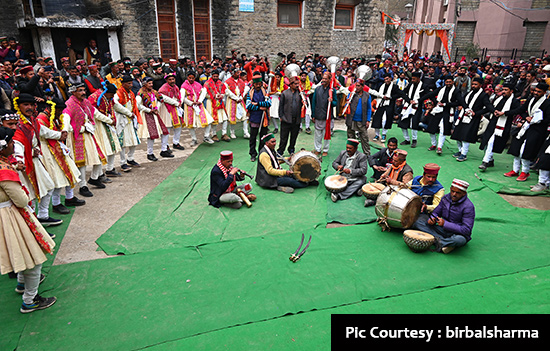 Nati-The folk dance of Himachal.
Nati-The folk dance of Himachal. There
are many interesting facets of the festival like six Narol Devis do not participate in the procession. They stay at Rupeshwari Behra in Raj Mahal during the
entire celebration. It is believed that they are great friends and during this
time catch up with each other.
Traditions
like these are the backbone of our society and connect us to our roots.
Notwithstanding
the pandemic of 2020 and 2021 (mostly subsided as on date of writing), the spirit
of the festival and Our heritage lives on.
Chief
Minster Jai Ram Thakur, inaugurated function by flag hosting. All
representative devotees showcased their regional Natti dances, dressed in traditional attires.
 Wrestling at Paddal ground during fair.
Wrestling at Paddal ground during fair. About Author Monika is a Pahadi from district Mandi, Indian Institute of Management Lucknow graduate, passionate about building brands, part-time astrologer and full-time mother. She presents short snippets from our scriptures and culture on Utube. Link
to her YouTube channel. Do check it out.
Mandi based senior journalist Birbal Sharma contributed to this article and shared lovely images. We are grateful to him.
Also read
1. Triloknath Mandir, Mandi
2. Albums of 12 Jyotirlings
3. Albums of Shiv Temples
4. Reflections on Mahashivaratri